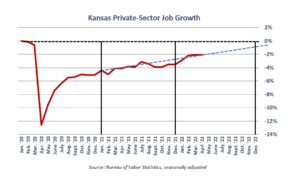The April Labor Report from the Kansas Department of Labor shows Kansas lost 100 private-sector jobs. Updated jobs numbers show that private-sector jobs in March were 3,000 more than what was estimated last month; previous job numbers are routinely updated in subsequent months to reflect more accurate data estimates for the time. At the same growth rate that Kansas has experienced since the start of 2021, the state will fully recover to its pre-pandemic level of jobs far into 2023. This decline in job growth occurs alongside growing concern over a national recession.
 The main job losses came from Professional and Business Service jobs, which lost 3,100 positions. Some sectors actually saw growth – Manufacturing gained 800 jobs, Education and Health Services gained 500 jobs, and Leisure and Hospitality gained 1,300 jobs. Other sectors like Information and Financial services saw small gains and losses of below 200 jobs. At the same time, the government in the state expanded by 600 jobs.
The main job losses came from Professional and Business Service jobs, which lost 3,100 positions. Some sectors actually saw growth – Manufacturing gained 800 jobs, Education and Health Services gained 500 jobs, and Leisure and Hospitality gained 1,300 jobs. Other sectors like Information and Financial services saw small gains and losses of below 200 jobs. At the same time, the government in the state expanded by 600 jobs.
The unemployment rate in Kansas sits at 2.4%, which is the same as an updated unemployment rate for March, which previously sat at 2.5%. At the same time, Kansas’ labor force participation rate increased from 66.2% to 66.3% – though, before its update, last month also had these results but has since been changed to show that the labor force participation rate stayed at 66.2%. This is all to say that Kansas is still below its pre-pandemic participation rate, which in January 2020 was 66.9%.
Kansas’s low unemployment rate is great news and is a sign that people who are going out in search of a job can find them. The issue is with job creation. Kansas is still 24,500 private-sector jobs below its pre-pandemic levels, while at least 11 other states like Arizona, Utah, and Idaho have all exceeded their pre-pandemic levels and continue to grow.
Fears of a looming recession are in the air. A recession is defined by two consecutive quarters with a decline in GDP. The first quarter of the year saw the U.S. economy shrank by -1.4%, so another poor quarter would mean a recession.
While the post-lockdown economy has seen high consumer spending, many of the current woes come from supply chain issues and inflation. One example comes from trucking. Because of the ongoing energy crisis via Russia’s invasion of Ukraine and a decrease in global refining capacity, the price of diesel fuel has seen a $2.20 increase in its average per-gallon price over the past year, which combined with difficulties finding truck drivers, has caused the cost of shipping goods to increase.
Much of the current inflation is related to the billions in federal aid that have hit Kansas and other states. The CARES and ARPA relief have provided roughly $2.6 billion for the Kansas state government and hundreds of millions more for local entities. This policy replicated in many different fashions across all 50 states, on top of other spending like the $1 trillion infrastructure bill, means that governments and their economies are awash in cash, thus causing inflation.





